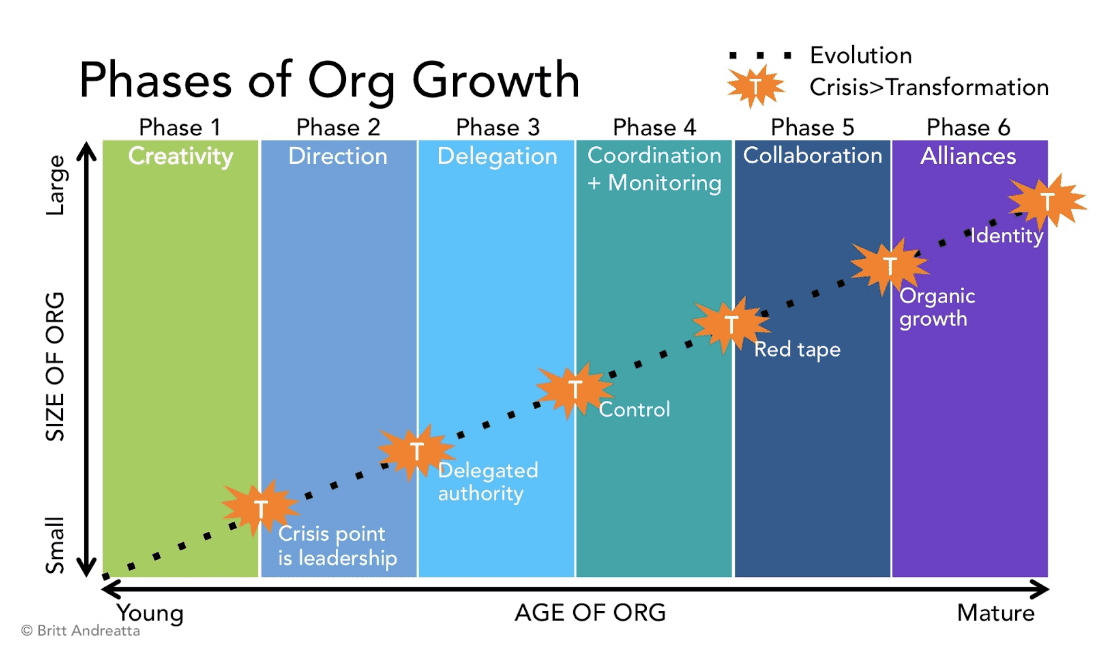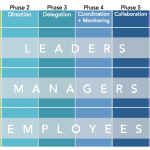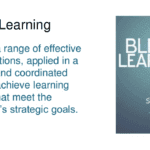This website uses cookies so that we can provide you with the best user experience possible. Cookie information is stored in your browser and performs functions such as recognising you when you return to our website and helping our team to understand which sections of the website you find most interesting and useful.
Nurture and Anticipate Growth with the Greiner Curve

If you have worked at companies of different sizes and stages of development, you may have noticed, as I eventually did, that as organizations grow and change they tend to develop the same way. And the research supports this. I've found Dr. Larry Greiner's work at USC's Marshall School of Business helpful when assessing the organizations I work with. His Greiner Curve identifies six distinct phases organizations move through, though the pace depends on differences in a company's growth. For example, a tech startup will move through these phases in a matter of months or years compared to a traditional international banking institution that might take decades. The pace is generated by how quickly an organization adds headcount, so "high-growth" mode can really drive substantial change.
Regardless of how long it takes, each phase leads to a crisis point when the current structure can no longer support the organization's needs. These crisis points push change, transforming the organization to the next phase, after which it may experience a period of relative stability until it evolves to the next crisis point.
Using the Greiner Curve to Your Advantage
When I consult with leaders, I ask them to identify their organization's overall phase, plus the phases for each of the functions as this can provide valuable information for designing effective learning solutions. As you read through the phases, think about your organization. Where does it fall on the model? More importantly, can you tell what crisis point and transformation is coming?
1. Growth through creativity, where the founders build the organization
The organization starts small. People wear many hats and communication is spontaneous and informal. As it grows it reaches a crisis point of leadership where professional management needs to be brought in to help run increasingly complex functions like marketing and human resources.
2. Growth through direction
New management expands functions and the organization develops new products and services. Eventually, the scale of the offerings gets too big for the leaders to monitor, which creates the crisis point of autonomy where work and authority need to be delegated to others.
3. Growth through delegation
Top management adds layers of hierarchy, focusing on long-term strategy rather than daily operations. The organization's size starts to stress current policies and channels of communication, creating the crisis point of control, where an organization's different parts need to work together better.
4. Growth through coordination and monitoring
New policies and procedures are introduced to establish structure. At first, this effort is helpful in bringing stability and consistency to the broader scope but eventually leads to the inevitable crisis point of red tape, where bureaucracy gets burdensome.
5. Growth through collaboration
Bureaucracy is replaced by scalable and agile systems that support more flexibility. Emotionally intelligent leaders are trusted to use good judgment instead of relying on a rigid decision-making system. This leads to the crisis point of internal growth, where the organization must look outside for new opportunities.
6. Growth through alliances
The organization can only solve its challenges by partnering with other organizations through actions like outsourcing, mergers, etc. This expansion ultimately creates the crisis point of identity, where the organization must refocus on its vision, mission, and strategy.
Keep in mind it's not uncommon to be on the edge between two phases, or for one core part of the business to be more developed and in a different phase than newer functions.
In any case, inform your learning strategies and solutions by identifying your company's place on the model. What's the current crisis point? And-even more importantly-what's the next phase on the horizon? Knowing this can help you proactively prepare NOW, rather than just react to disruptions after the fact. When you use the Greiner Curve correctly, it's almost like gazing into a crystal ball that keeps you see what's coming before it happens. Other leaders will notice and seek your counsel as you become known as a reliable strategist for ongoing, evolving success.
Related Blogs
JOIN OUR COMMUNITY
Be the first to know of Dr. Britt Andreatta's latest news and research.






